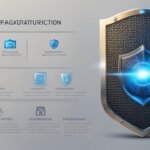Table of Contents
In today’s digital age, data security has become a top priority for businesses and individuals alike. With cyber threats on the rise, it’s essential to establish measures that will protect sensitive information from unauthorized access.
One such measure is Multi-Factor Authentication (MFA), a process that adds an extra layer of security to user login credentials. By requiring more than one method of authentication, MFA helps ensure that only authorized individuals can access sensitive data.
In this guide, we will explore what MFA is and its importance in securing data. We will delve into the basics of the MFA process and its different factors and authentication methods. Additionally, we will provide insights into best practices for implementing MFA and highlight its security benefits.
Key Takeaways
- Multi-Factor Authentication (MFA) adds an extra layer of security to user login credentials
- MFA requires more than one method of authentication to ensure only authorized individuals can access sensitive data
- The different factors of MFA include something you know, something you have, and something you are
- MFA implementation best practices include user education, selecting the right solution for different scenarios, and regular testing
- MFA helps prevent unauthorized access to sensitive data and enhances overall security measures
The Basics of Multi-Factor Authentication
Multi-Factor Authentication (MFA) is a process that involves using two or more different factors for authentication. The objective is to enhance security by requiring users to provide multiple pieces of evidence to prove their identity.
The MFA process typically involves three different factors: something you know, something you have, and something you are. Something you know refers to a password or a PIN, something you have could be a security token or a smartphone, and something you are refers to biometric data like fingerprints or facial recognition.
Various authentication methods are used in MFA to verify these factors. These methods include:
- One-time passwords (OTPs) delivered via SMS, email, or mobile app
- Smartphone authentication with fingerprint or facial recognition
- Security tokens that generate OTPs
- Software-based authentication apps
Each of these methods has its strengths and weaknesses, depending on the implementation and the environment. For example, hardware tokens offer high security levels but can be expensive to procure and maintain. OTPs are convenient but can be vulnerable to interception or phishing attacks.
It’s vital to consider the different factors and authentication methods when designing an MFA system. Combining factors and leveraging different authentication methods can create a robust, layered security approach that is more secure than relying on a single authentication method.
Implementing MFA for Enhanced Security
Implementing Multi-Factor Authentication (MFA) is an essential step in enhancing cybersecurity. Here, we will explore the best practices for MFA implementation, highlighting the security benefits it brings to protect sensitive data and prevent unauthorized access.
Best Practices for MFA Implementation
When implementing MFA, it is crucial to follow the best practices to avoid any vulnerabilities that could compromise security. The following are recommended practices:
- Include at least two factors for authentication.
- Use strong passwords, and consider updating them regularly.
- Implement MFA on all devices and applications that handle sensitive data.
- Choose an MFA solution that meets your organization’s needs, is easy to use, and has a low error rate.
Following these best practices ensures the maximum level of protection for your sensitive information.
The Security Benefits of MFA
The implementation of MFA prevents unauthorized access to your data. By adding an extra layer of protection, MFA reduces the risk of unauthorized access, data breaches, and other security incidents. MFA makes it incredibly challenging for attackers to get past the authentication process, as they would need more than one authentication factor, which is difficult to obtain.
Considerations for Selecting the Right MFA Solution
While selecting the right MFA solution, consider the following:
- The type of factors included in the authentication process of the MFA solution.
- The compatibility of the MFA solution with your existing infrastructure.
- The ease of use and maintenance of the MFA solution.
- The cost-effectiveness of the solution.
Choosing the right MFA solution involves assessing your organization’s specific needs and requirements, while considering the listed factors.
Implementing MFA is a crucial aspect of securing data. By following the best practices for MFA implementation, organizations can reap the benefits of enhanced security. Selecting the right MFA solution for your organization also significantly contributes to an effective MFA implementation and a secure digital environment.
Conclusion
In conclusion, Multi-Factor Authentication (MFA) is an essential security measure for protecting sensitive data in today’s digital landscape. By requiring multiple factors for authentication, MFA significantly reduces the risk of unauthorized access to sensitive information.
Throughout this guide, we have explored what MFA is, its basic principles, and various methods for implementing it. We have highlighted best practices for deploying MFA effectively and selecting the right solution for different scenarios.
It is essential to note that while MFA provides enhanced security, it is not a foolproof solution. There is no one-size-fits-all approach to cybersecurity, and organizations must continually assess their security measures to ensure they remain effective against evolving threats.
By understanding the fundamentals of MFA and its role in security, individuals and organizations can make informed decisions to protect their data. Remember, the security of your information is in your hands and is a shared responsibility. Stay vigilant, stay secure.
FAQ
What is Multi-Factor Authentication (MFA)?
Multi-Factor Authentication (MFA) is a security process that requires users to provide more than one form of identification to access a system or application. It adds an additional layer of protection by combining two or more factors, such as something the user knows (password), something the user has (smartphone), or something the user is (fingerprint).
Why is MFA important for securing data?
MFA is important for securing data because it adds an extra level of protection against unauthorized access. With MFA, even if a hacker manages to steal or guess a user’s password, they would still need the additional factor (such as a unique code from a mobile app) to gain access. This significantly reduces the risk of data breaches and enhances overall security.
What are the different factors involved in MFA?
The different factors involved in MFA are typically categorized as follows:
– Something the user knows (e.g., password, PIN)
– Something the user has (e.g., smartphone, hardware token)
– Something the user is (e.g., fingerprint, facial recognition)
By combining two or more of these factors, MFA provides an extra layer of security beyond just a username and password.
What are the common authentication methods used in MFA?
Common authentication methods used in MFA include:
– One-time passwords (OTPs) sent via SMS or email
– Mobile apps that generate unique codes (e.g., Google Authenticator)
– Hardware tokens that generate temporary codes
– Biometric authentication (e.g., fingerprint or facial recognition)
These authentication methods help ensure that only authorized users can access sensitive data or systems.
How can MFA be implemented for enhanced security?
To implement MFA for enhanced security, consider the following best practices:
– Use MFA for all users, especially for privileged accounts.
– Select appropriate authentication methods based on the sensitivity of the data.
– Regularly update passwords and ensure varied factors are used.
– Educate users about the importance of MFA and how to use it properly.
– Monitor MFA logs and promptly respond to any suspicious activities.
By following these practices, organizations can significantly strengthen their security posture.
What are the security benefits of implementing MFA?
Implementing MFA offers several security benefits, including:
– Protection against password-based attacks and brute-force attempts.
– Reduced risk of unauthorized access and data breaches.
– Enhanced security for remote access and cloud-based applications.
– Improved compliance with industry regulations and data protection standards.
– Increased user trust and confidence in the security of sensitive information.
How do I select the right MFA solution for my needs?
When selecting an MFA solution, consider the following factors:
– Compatibility with existing systems and applications.
– Scalability to accommodate future growth or changes.
– User-friendliness and ease of deployment.
– Integration with other security tools and systems.
– Vendor reputation and track record of providing reliable solutions.
Taking these factors into account will help you choose an MFA solution that aligns with your specific requirements.












